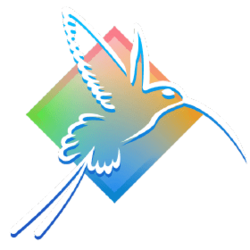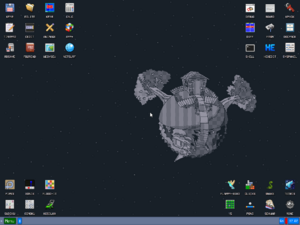KolibriOS facts for kids
Quick facts for kids  |
|
 |
|
| Company / developer | KolibriOS Project Team |
|---|---|
| Programmed in | FASM |
| Working state | Active |
| Source model | Open source |
| Initial release | 2004 |
| Latest stable release | 0.7.7.0+8770 / August 1, 2024 |
| Available language(s) | English, Russian, Spanish |
| Available programming languages(s) | FASM, C/C++, Pascal, Python, BF, Lua etc. |
| Supported platforms | x86 |
| Kernel type | Monolithic |
| Default user interface | KolibriOS Kernel API |
| License | GPL-2.0-only with binary blobs |
| Preceded by | MenuetOS |
KolibriOS is a special operating system for computers. Think of an operating system as the main program that makes your computer work, like Windows or macOS. KolibriOS is unique because it's open-source. This means its code is free for anyone to see and change.
It's made for common x86 computers and is written entirely in FASM assembly language. This is a very basic computer language, which helps make KolibriOS super fast. It started in 2004, based on another system called MenuetOS. KolibriOS works on computers with processors like the i586 or newer.
Even though KolibriOS is tiny and can fit on a small floppy disk, it has a full graphical user interface. This means you see windows, icons, and menus, just like on bigger operating systems. It can also do many tasks at once smoothly and connect to the internet. Plus, it comes with lots of useful programs already included!
The name "Kolibri" comes from a Slavic word for hummingbird. This name was chosen because the operating system is very small and quick, just like a hummingbird.
How KolibriOS Was Developed
KolibriOS began as a copy, or "fork," of MenuetOS. MenuetOS had both 32-bit and 64-bit versions. KolibriOS became very popular in Russia and other nearby countries. This led to many people helping to improve the project.
The first version of KolibriOS came out in 2004. It was created by Marat Zakiyanov, also known as "mario79." He wanted to fix some issues for the Russian version of MenuetOS. Soon after KolibriOS started, the creator of MenuetOS decided to focus only on the 64-bit version. That 64-bit version was "closed source," meaning its code wasn't free to see.
But KolibriOS stayed 32-bit and remained open source. This allowed many people to keep working on it. Developers from countries like Russia, Kazakhstan, Ukraine, and Germany have all helped build KolibriOS. Evgeny Grechnikov, or "Diamond," helps put together the different parts of the system for release.
There are also special versions of KolibriOS. One, called KolibriACPI, has better support for managing computer power. Another, Kolibri-A, is made for special devices and hardware projects.
What KolibriOS Can Do
KolibriOS is very small. Most versions can fit on a single 1.44 MB floppy disk. Because it's written in assembly language, it starts up in just a few seconds on many different devices.
It can start from various types of computer disks. These include NTFS, Ext2/3/4, FAT12/16/32, exFAT, and CD/DVD disks. You can also start it from Coreboot or even from inside Microsoft Windows.
KolibriOS has a graphical interface that works well with VESA graphics. It can run many programs at the same time without slowing down. It also comes with over 250 built-in programs. These include a word processor, a picture viewer, a music player, and even a web browser. There's also a code editor that helps you write programs.
You can also use a "shell" in KolibriOS. This is a way to type commands to your computer, similar to how some older or specialized computer systems work.
Hardware KolibriOS Supports
KolibriOS can work with USB 1.1 and 2.0 devices. It supports USB hubs, which let you plug in more USB devices. However, it mainly supports USB devices like keyboards, mice, and USB flash drives.
It also works with internal hard drives that use PATA/IDE and SATA connections. KolibriOS understands many different ways computers store files. These include FAT12, FAT16, FAT32, ext2, ext3, ext4 (partially), NTFS (for reading files), exFAT (read-only), XFS, and CDFS.
KolibriOS can connect to the internet using TCP/IP and certain Ethernet network cards. It also supports sound on some motherboards. This includes Intel High Definition Audio and AC'97 sound chips from companies like Intel and nForce. The system claims to work with almost any video card, and it has special drivers for some Intel or AMD cards.
To run KolibriOS, your computer needs to meet these basic requirements:
- An i586-compatible CPU. This means an older type of computer processor. It can even run on some i486 machines with small changes.
- At least 8 MB of RAM. RAM is like your computer's short-term memory.
- A VESA-compatible graphics card. This is what helps your computer show images on the screen.
- A 1.44 MB 3.5" floppy drive, a hard disk drive, a USB flash drive, or a CD-ROM drive to start the system.
- A keyboard and mouse. These can connect using COM, PS/2, or USB connections.
See also
 In Spanish: KolibriOS para niños
In Spanish: KolibriOS para niños

